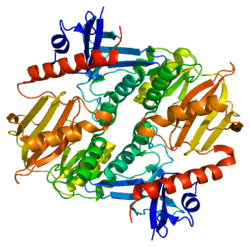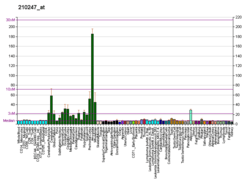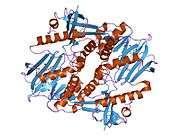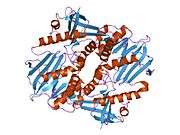Synapsin 2
Synapsin II is the collective name for synapsin IIa and synapsin IIb, two nearly identical phosphoproteins in the synapsin family that in humans are encoded by the SYN2 gene.[5][6] Synapsins associate as endogenous substrates to the surface of synaptic vesicles and act as key modulators in neurotransmitter release across the presynaptic membrane of axonal neurons in the nervous system.
Gene
Alternative splicing of the SYN2 gene results in two transcripts. The TIMP4 gene is located within an intron of this gene and is transcribed in the opposite direction.[6]
Protein
Synapsin II is a member of the synapsin family. Synapsins encode neuronal phosphoproteins which associate with the cytoplasmic surface of synaptic vesicles. Family members are characterized by common protein domains, and they are implicated in synaptogenesis and the modulation of neurotransmitter release, suggesting a potential role in several neuropsychiatric diseases. This member of the synapsin family encodes a neuron-specific phosphoprotein that selectively binds to small synaptic vesicles in the presynaptic nerve terminal.[6]
Synapsin II the collective name for two proteins, synapsin IIa and synapsin IIb, with synapsin IIa being the larger of the two isoforms. Their apparent molecular weights are 74,000 and 55,000 Da, per SDS gel electrophoresis.[7] Synapsin II along with synapsin I comprise approximately 9% of the proteins in highly purified samples of synaptic vesicles.
Structure
Synapsin II shares common domains within its amino acid sequence with other phosphoproteins in the synapsin family.[8] Sharing the same N-terminal, synapsin II diverges from synapsin I in its C-terminal domains. It is much shorter than synapsin I and is missing most of the elongated domains seen in synapsin I. Roughly 70% of the amino acid residues are common between the two synapsins,[7] which share common phosphorylation sites in the overlapping regions based on the homologous domains. Domain A of this neural protein contains phosphorylation sites for cAMP-dependent protein kinase and calcium/calmodulin-dependent protein kinase I, and domain B has two mitogen-activated protein kinase phosphorylation sites. At its B domain, between amino acids 43 and 121, synapsin II binds to a protein component in the cytosolic surface membrane of synaptic vesicles, organelles in neurons which carry neurotransmitters.[7]
Function
Synapsin II regulates synaptic function of neurons in the central and peripheral nervous system.[9] Synapsin IIa is the only synapsin isoform of the six synapsin isoforms (synapsin I-III each with isoforms A and B), which has been shown to significantly reverse synaptic depression and have a restorative effect on the density of synaptic vesicles within synapsinless neurons. Because of its restorative effect, synapsin IIa is believed to play a fundamental role in synaptic vesicle mobilization and reserve pool regulation in presynaptic nerve terminals.[10]
Lack of synapsins altogether in neurons, leads to behavioral alterations as well as epileptic-type seizures. The lack affects nervous signal transduction across excitatory and inhibitory synapses of neurons differently and is believed to be synapse-specific. Initial signal transduction appears to be unaffected by the lack of synapsins, but repeated stimulation of cultured synapsinless hippocampal neurons subsequently showed depressed responses at the excitatory synapse. At the inhibitory synapse, base signal transduction is reduced in neurons lacking pre-existing synapsins, but the reduced level of transduction is less affected by progressive stimulation.[11]
However, the restoration of synapsin IIa to neurons without pre-existing synapsins, can partially recover presumably lost signal transduction and slow the depression of synaptic response with progressive stimulation. Its isoform synapsin IIb may have a similar but weaker effect. Through fluorescence and staining, it has been demonstrated that synapsin IIa increases the number and density of glutamatergic synaptic vesicles in the nerve terminal of neural axons. The recovery of nervous signal transduction is attributed to the increase in density of synaptic vesicles, which carry neurotransmitters to the synaptic cleft, and the amount of synaptic vesicles in the reserve pool in the presence of synapsin IIa.[10] In turn, this is thought to increase the number of vesicles available for mobilization from the reserve pool to the ready-release pool. The reserve pool is the pool of synaptic vesicles which reside in the nerve terminal away from the presynaptic membrane of the axon, but are not in the ready to release or ready-release pool. Those vesicles in the ready-release pool reside very close to the presynaptic membrane and are primed to release neurotransmitters for nervous signal transduction.
Clinical significance
Mutations in the SYN2 gene may be associated with abnormal presynaptic function and schizophrenia.[6]
References
- GRCh38: Ensembl release 89: ENSG00000157152 - Ensembl, May 2017
- GRCm38: Ensembl release 89: ENSMUSG00000009394 - Ensembl, May 2017
- "Human PubMed Reference:". National Center for Biotechnology Information, U.S. National Library of Medicine.
- "Mouse PubMed Reference:". National Center for Biotechnology Information, U.S. National Library of Medicine.
- Li L, Chin LS, Greengard P, Copeland NG, Gilbert DJ, Jenkins NA (July 1995). "Localization of the synapsin II (SYN2) gene to human chromosome 3 and mouse chromosome 6". Genomics. 28 (2): 365–6. doi:10.1006/geno.1995.1162. PMID 8530057.
- "Entrez Gene: SYN2 synapsin II".
- Thiel G, Südhof TC, Greengard P (September 1990). "Synapsin II. Mapping of a domain in the NH2-terminal region which binds to small synaptic vesicles". J. Biol. Chem. 265 (27): 16527–33. PMID 2118908.
- Südhof TC, Czernik AJ, Kao HT, Takei K, Johnston PA, Horiuchi A, Kanazir SD, Wagner MA, Perin MS, De Camilli P (September 1989). "Synapsins: mosaics of shared and individual domains in a family of synaptic vesicle phosphoproteins". Science. 245 (4925): 1474–80. Bibcode:1989Sci...245.1474S. doi:10.1126/science.2506642. PMID 2506642.
- Greengard P, Valtorta F, Czernik AJ, Benfenati F (February 1993). "Synaptic vesicle phosphoproteins and regulation of synaptic function". Science. 259 (5096): 780–5. Bibcode:1993Sci...259..780G. CiteSeerX 10.1.1.336.2100. doi:10.1126/science.8430330. PMID 8430330.
- Gitler D, Cheng Q, Greengard P, Augustine GJ (October 2008). "Synapsin IIa controls the reserve pool of glutamatergic synaptic vesicles". J. Neurosci. 28 (43): 10835–43. doi:10.1523/JNEUROSCI.0924-08.2008. PMC 2605971. PMID 18945891.
- Gitler D, Takagishi Y, Feng J, Ren Y, Rodriguiz RM, Wetsel WC, Greengard P, Augustine GJ (December 2004). "Different presynaptic roles of synapsins at excitatory and inhibitory synapses". J. Neurosci. 24 (50): 11368–80. doi:10.1523/JNEUROSCI.3795-04.2004. PMC 6730366. PMID 15601943.
- Hosaka, M; Südhof T C (Jun 1999). "Homo- and heterodimerization of synapsins". J. Biol. Chem. 274 (24): 16747–53. doi:10.1074/jbc.274.24.16747. ISSN 0021-9258. PMID 10358015.
Further reading
- Südhof TC, Czernik AJ, Kao HT, et al. (1989). "Synapsins: mosaics of shared and individual domains in a family of synaptic vesicle phosphoproteins". Science. 245 (4925): 1474–80. Bibcode:1989Sci...245.1474S. doi:10.1126/science.2506642. PMID 2506642.
- Greengard P, Valtorta F, Czernik AJ, Benfenati F (1993). "Synaptic vesicle phosphoproteins and regulation of synaptic function". Science. 259 (5096): 780–5. Bibcode:1993Sci...259..780G. doi:10.1126/science.8430330. PMID 8430330.
- Petersohn D, Schoch S, Brinkmann DR, Thiel G (1995). "The human synapsin II gene promoter. Possible role for the transcription factor zif268/egr-1, polyoma enhancer activator 3, and AP2". J. Biol. Chem. 270 (41): 24361–9. doi:10.1074/jbc.270.41.24361. PMID 7592648.
- Li L, Chin LS, Greengard P, et al. (1996). "Localization of the synapsin II (SYN2) gene to human chromosome 3 and mouse chromosome 6". Genomics. 28 (2): 365–6. doi:10.1006/geno.1995.1162. PMID 8530057.
- Xie Y (1996). "Cloning and sequencing analysis of a human synapsin IIb-encoding brain cDNA". Gene. 173 (2): 289–90. doi:10.1016/0378-1119(96)00234-X. PMID 8964517.
- Hosaka M, Südhof TC (1998). "Synapsins I and II are ATP-binding proteins with differential Ca2+ regulation". J. Biol. Chem. 273 (3): 1425–9. doi:10.1074/jbc.273.3.1425. PMID 9430678.
- Witke W, Podtelejnikov AV, Di Nardo A, et al. (1998). "In mouse brain profilin I and profilin II associate with regulators of the endocytic pathway and actin assembly". EMBO J. 17 (4): 967–76. doi:10.1093/emboj/17.4.967. PMC 1170446. PMID 9463375.
- Hosaka M, Südhof TC (1999). "Homo- and heterodimerization of synapsins". J. Biol. Chem. 274 (24): 16747–53. doi:10.1074/jbc.274.24.16747. PMID 10358015.
- Porton B, Kao HT, Greengard P (2000). "Cloning of cDNAs encoding human synapsins IIa and IIb". DNA Seq. 10 (1): 49–54. doi:10.3109/10425179909033936. PMID 10565545.
- Hosaka M, Hammer RE, Südhof TC (1999). "A phospho-switch controls the dynamic association of synapsins with synaptic vesicles". Neuron. 24 (2): 377–87. doi:10.1016/S0896-6273(00)80851-X. PMID 10571231.
- Kao HT, Porton B, Hilfiker S, et al. (2000). "Molecular evolution of the synapsin gene family". J. Exp. Zool. 285 (4): 360–77. doi:10.1002/(SICI)1097-010X(19991215)285:4<360::AID-JEZ4>3.0.CO;2-3. PMID 10578110.
- Spielhaupter C, Schätzl HM (2002). "PrPC directly interacts with proteins involved in signaling pathways". J. Biol. Chem. 276 (48): 44604–12. doi:10.1074/jbc.M103289200. PMID 11571277.
- Jaffrey SR, Benfenati F, Snowman AM, et al. (2002). "Neuronal nitric-oxide synthase localization mediated by a ternary complex with synapsin and CAPON". Proc. Natl. Acad. Sci. U.S.A. 99 (5): 3199–204. Bibcode:2002PNAS...99.3199J. doi:10.1073/pnas.261705799. PMC 122496. PMID 11867766.
- Strausberg RL, Feingold EA, Grouse LH, et al. (2003). "Generation and initial analysis of more than 15,000 full-length human and mouse cDNA sequences". Proc. Natl. Acad. Sci. U.S.A. 99 (26): 16899–903. Bibcode:2002PNAS...9916899M. doi:10.1073/pnas.242603899. PMC 139241. PMID 12477932.
- Ota T, Suzuki Y, Nishikawa T, et al. (2004). "Complete sequencing and characterization of 21,243 full-length human cDNAs". Nat. Genet. 36 (1): 40–5. doi:10.1038/ng1285. PMID 14702039.
- Chen Q, He G, Wang XY, et al. (2004). "Positive association between synapsin II and schizophrenia". Biol. Psychiatry. 56 (3): 177–81. doi:10.1016/j.biopsych.2004.05.010. PMID 15271586.
- Chen Q, He G, Qin W, et al. (2005). "Family-Based Association Study of Synapsin II and Schizophrenia". Am. J. Hum. Genet. 75 (5): 873–7. doi:10.1086/425588. PMC 1182116. PMID 15449241.







